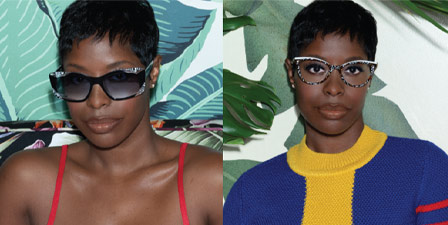 |
By Preston Fassel, BS
There are eight million stories in the naked dispensary. This is one of them:
At approximately 11:30 a.m. on a Saturday morning, a woman drifted out of a dispensary, her cell phone filled with photos of Jennifer Aniston and Jennifer Aniston's woefully outdated 90's frames. Watching her leave, an optician remarked, "It's hard to believe, but, some people actually care what celebrities wear!"
The statement is a telling one. It's indicative of a mindset that has become prevalent in the world of optics: The idea that eyeglass frame fashion evolves separately from the general world of fashion within a sort of bubble, free from external influences. It's a tempting view to take: Until very recently, even the most popular frames were manufactured by companies whose main forte was eyeglasses. Izod, Armani, and Ralph Lauren made the clothes people wanted, while Bausch and Lomb, Shuron, American Optical, and Art-Craft made the glasses people wanted. Then, the barriers broke down: designer labels got slapped on eyewear, and seemingly overnight, glasses were no longer medical devices, but accessories.
The reaction to this is understandable: since glasses were stigmatized for so long, and set away from the realm of accessories, many of us would like to think they're still in a league of their own—popular, but apart from the crowd, and therefore not restrained or defined by the changing fads that dictate popular fashion. Subscribing to this idea prevents us from recognizing and analyzing trends that can better help us provide our patients with the frames they're after... and even identify what they want before they want it.
 |
TRICKLE DOWN FASHION
While many individuals may be inspired to acquire a particular article of clothing or accessory after seeing it on their favorite movie star, politician, or singer, most of us will find ourselves unwittingly wearing something at some point that owes its' availability to a celebrity. This is due to trickle down fashion.
When a celebrity dresses in a particular way, or dons a particular article of clothing, trend-followers—who tend to be a fairly affluent bunch—seek out the fashion for themselves. Many times, the style may be unique or one-of-a-kind. Other times, it may be too expensive for anyone BUT a celebrity to afford. This is where design houses come in. In order to turn a profit from fashionistas' desire to own what they saw Angelina Jolie wear at the Golden Globes, design houses will turn out their own versions of the fashion at a (slightly) more affordable price than the "real deal." This creates a cascade effect in which design houses at lower and lower price echelons create their own replicas, targeting shoppers at different levels of the economic strata. As more and more people of higher social stratas begin adopting a particular fashion, it becomes more and more visible in daily life. As people have a basic need to want to "fit in" with the crowd, the general public begins to feel influenced, consciously or subconsciously, and starts to seek out the style for themselves, resulting in the need for manufacturers of clothing for mass retail to churn out their own versions of a particular style. So when Tom Cruise starts a craze in LA by wearing wingtip side-zip ankle boots, don't be surprised to find a $20 version at Wal-Mart in another six months.
A REAL SPECTACLE...
Believe it or not, this is how eyeglass fashion has developed over time, as well. Don't believe me? Go take a look at your dispensary. Odds are you've got at least a few pair of zyl frames that start out dark at the top and slowly turn a lighter shade as they near the bottom; or perhaps you've (also) got zyl frames that are a solid, dark color at the top and completely clear at the bottom. Even with the resurgence in zyls, odds are, you probably didn't have many (or any) frames like these until the last three years or so. Why the sudden re-appearance?
 |
In 2011, a film called The Tree of Life premiered, starring Brad Pitt. A sort of Christian version of 2001: A Space Odyssey, the movie concerns the daily life of a family in 1950's Texas. You can probably see where this is going. In the film, Pitt prominently wears a vintage frame called the Darren, produced by a company called Graceline. Though they are fades, the frames also bear a resemblance to plastic browlines.
The Tree of Life was a tremendous hit with critics and sharply divided audiences, making it one of the most talked about films of the year. Pitt's glasses (which were heavily featured in the film's marketing campaign) were the perfect vintage-appropriate twist on the retro eyeglass craze, and became the must-have item for eyeglass aficionados. A company named Allyn Scura seized upon a deadstock supply of the Darren, making them virtually the exclusive source for the frames. So began the effect of trickle down fashion, until replicas of those very frames ended up sitting on the wall of your dispensary.
SO WHAT'S IT ALL ABOUT, ALFIE?
As a part of the fashion industry, it's imperative we keep ourselves aware of the latest trends. Being aware of the next big thing before the trickle-down process reaches your dispensary will allow you to be prepared and stock up on the styles your patients will soon be seeking out. Though we are first and foremost medical professionals, we're also style advisers; as such, trade shows have taken on a new importance as a way to see what new styles are being offered, in order to cross reference them with the latest GQ or Vogue or the current hot television show or movie. (20/20 Magazine's Celebrity Watch and Vision Monday's New Brands will do some of this work for you, but only so much). By doing so, we can keep abreast of what's out there... and what's coming our way.













